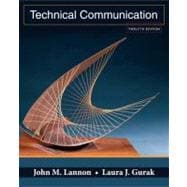Technical Communication offers complete coverage of technical communication, business communication, and professional writing in a user-friendly writing style. The topics move from basic foundational concepts, to chapters on research, visuals, style, document design, usability, and finally to specific documents (basic workplace correspondence to more complex documents, technologies, and oral presentations).
Simple, straightforward explanations of concepts and audience/purpose analyses of specific document types make the learning process easy for students who often have a difficult time separating technical communication from academic writing.
The appendix includes thorough coverage of MLA, APA, and CSE (Council of Science Editors) documentation styles, and a handbook of grammar, mechanics, and usage. All descriptions of and instructions for creating technical documents are accompanied by clear, annotated model documents. In addition, graphic illustrations appear throughout the book to make abstract concepts easy to understand. Checklists and Projects provide plentiful opportunities to learn and reinforce chapter topics.
Thoroughly revised and updated, this newly designed full color and streamlined 12th edition places special emphasis on up-to-the-minute coverage of ethics, global communication, and technology.








